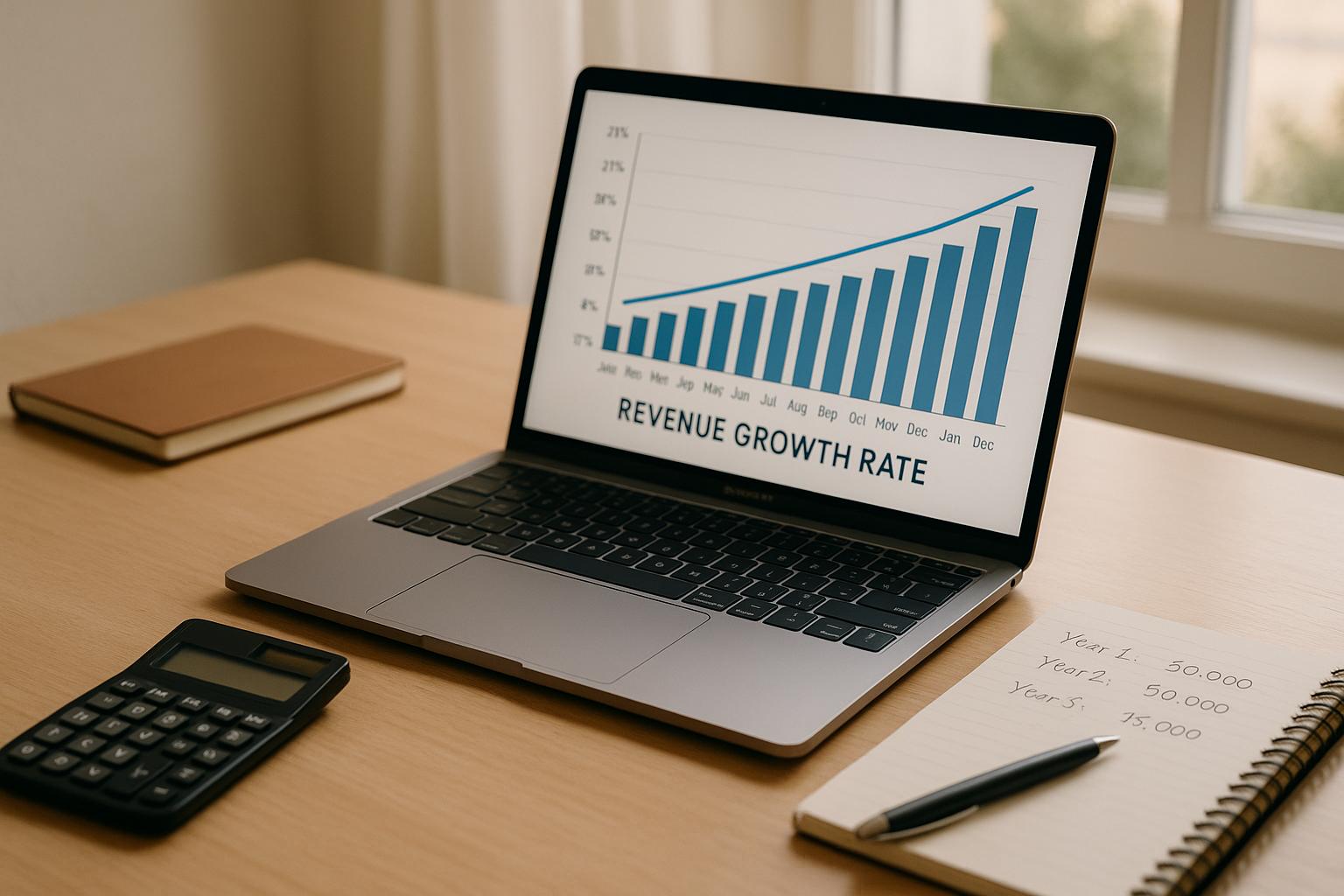How to Match Investors to Growth Stages

Finding the right investors for your business depends on aligning their expertise and expectations with your company’s growth stage. Here’s a quick breakdown:
- Early-Stage: Focus on product development and proving your idea. Seek funding from angel investors, friends and family, or crowdfunding.
- Growth-Stage: Scale operations and grow revenue. Look for venture capital firms and accelerators to back your expansion.
- Late-Stage: Maintain market leadership and explore new opportunities. Partner with private equity firms and institutional investors.
Key Takeaways:
- Match your growth stage with investor priorities to avoid misaligned goals.
- Highlight your financial metrics, market traction, and clear growth plans.
- Work with financial advisors to refine your pitch, negotiate terms, and present strong financials.
Quick Tip: Build a focused list of potential investors by researching their portfolios, preferred industries, and stage preferences. Tailor your pitch to show how their expertise aligns with your business goals.
Growth Stages and Funding Requirements
Knowing your company's growth stage is essential when approaching investors. Each stage has its own characteristics and funding requirements, which align with specific types of investors. Here's a breakdown of the main growth stages and the types of investors they typically attract.
Early-Stage: Laying the Foundation
Early-stage companies are usually focused on developing prototypes, testing their market, and building an initial customer base. Revenue is often minimal - or nonexistent - at this point. Funding during this stage often comes from angel investors, friends and family, or crowdfunding platforms. The primary goal here is product development and proving that the market exists for your idea.
Growth-Stage: Expanding Operations
At the growth stage, companies have already validated their product-market fit and are generating early revenue. Market traction is evident, and the focus shifts to scaling operations and reaching a broader audience. Funding during this phase typically comes from venture capital firms and accelerators, which provide the resources needed for expansion and market penetration.
Late-Stage: Dominating the Market
Late-stage companies have established themselves as market leaders with consistent and strong revenue streams. The focus at this point is on sustaining growth and expanding market dominance. Investors such as private equity firms and institutional investors are common at this stage, offering the capital needed to maintain leadership and explore further opportunities.
Growth Stages Summary
| Growth Stage | Key Investor Types | Revenue/Validation Stage |
|---|---|---|
| Early-Stage | Angel Investors, Friends & Family, Crowdfunding | Limited or no revenue; early product development |
| Growth-Stage | Venture Capital Firms, Accelerators | Validated product-market fit with early revenue |
| Late-Stage | Private Equity Firms, Institutional Investors | Established strong revenue and market leadership |
For tailored advice, working with financial advisors like Phoenix Strategy Group can help you accurately assess your growth stage and connect with the right investors. Their expertise ensures you align with funding sources that match your current needs and long-term plans. Use this framework to guide your approach and secure the support that aligns with your company’s goals.
How to Choose the Right Investors
After aligning investor types with your growth stage, the next step is selecting partners whose expertise and expectations match your current goals.
Finding Investors with Industry Experience
An investor's knowledge of your industry can be just as important as the funding they provide. To assess this, take a close look at their portfolio and past investments in your sector. For instance, a healthcare company might benefit from investors who have experience in medical technology, while a SaaS business could prioritize those with a background in enterprise software. The idea is to find investors who grasp the specific challenges and rules of your market.
Once you've identified these experts, tailor your pitch to meet their expectations and demonstrate how your business fits their focus.
Aligning with Investor Expectations
Investor priorities shift depending on your company's stage of growth. Early-stage investors often look for signs of product-market fit and initial traction. Growth-stage investors, on the other hand, might focus on steady revenue growth and healthy unit economics. For later-stage companies, the spotlight typically falls on profitability, market dominance, and a clear plan for an eventual exit. Adjust your approach to align with what investors value most at each stage.
Evaluating Deal Terms
The terms of an investment deal can have a lasting impact on your business. Early-stage deals often involve lower valuations as you're still proving your concept, while growth and late-stage deals reflect your business's ability to scale and lead in the market. Equity stakes also vary - angel investors may take a smaller share, while venture capital or private equity firms might seek a larger stake.
Key terms to review include:
- Board seat arrangements
- Voting rights and control provisions
- Anti-dilution clauses
- Liquidation preferences
- Conditions tied to future fundraising
Consulting experienced financial advisors, like those at Phoenix Strategy Group, can help you negotiate terms that align with your long-term vision.
sbb-itb-e766981
Steps to Connect with Investors
Creating Your Investor List
Start by building a focused list of potential investors through thorough research. Pay attention to their investment sizes, portfolios, and recent activities.
Use a spreadsheet to track key details about each investor, such as:
- Investment focus and preferred industries
- Typical check size range
- Stage preferences (early, growth, late)
- Recent investments in your sector
- Geographic preferences
- Alignment with your company’s goals
Focus on investors with a strong track record in your specific market. For example, if you’re running a SaaS company, prioritize firms that have successfully supported similar businesses at comparable growth stages. Once your list is ready, refine your company’s story to clearly communicate your strengths during your pitch.
Building Your Pitch
With your investor list prepared, it’s time to craft a pitch that highlights your financial performance and growth potential. Your pitch should effectively tell your company’s story using data that matters to investors.
Include these key elements in your pitch:
- Current financial metrics and KPIs
- Historical performance and growth trajectory
- Market opportunity and competitive position
- Clear plan for how funds will be used
- Realistic financial projections
"As our fractional CFO, they accomplished more in six months than our last two full-time CFOs combined. If you're looking for unparalleled financial strategy and integration, hiring PSG is one of the best decisions you can make." - David Darmstandler, Co-CEO, DataPath
Working with Financial Advisors
Financial advisors can be a game-changer when it comes to connecting with investors. They streamline your financials and open doors through their networks.
Here’s how a skilled financial advisor can help:
- Organize and present your financial data
- Build strong financial models
- Define key investor metrics
- Structure potential deals
- Guide complex negotiations
"PSG saved my dream. They helped us get our financials in order and renegotiate our lending agreements, pulling us through a tough financial crunch." - Norman Rodriguez, Founder / CEO, ElevateHire
Collaborating with financial advisors like Phoenix Strategy Group can elevate your investor outreach. They help you establish solid due diligence processes and create models that showcase your potential, making it easier to attract investors who match your growth stage.
Presenting your business as well-organized and data-driven is crucial. This demonstrates to investors that you understand your numbers and have a clear plan for growth. Regularly tracking metrics and holding weekly check-ins can keep your team aligned with these objectives, making your company even more appealing to investors.
Solving Common Investor Match Problems
Identifying Qualified Investors
Finding the right investors isn’t just about securing funds - it’s about aligning their expertise and goals with your company’s growth stage. To do this effectively, you need to ensure your financial metrics and unit economics are in sync with your current business needs.
Start by setting up an organized financial tracking system. Companies with clear KPIs and well-maintained financial records are far more likely to attract the right investors.
When assessing potential investors, consider these factors:
- Does their expertise align with your industry?
- Have they supported businesses at your growth stage before?
- Can they provide more than just funding, such as strategic insights or connections?
- Do they have a proven track record with similar companies?
Once you’ve identified potential investors, focus on building trust through open, ongoing communication.
"As a home service business owner, understanding financials and unit economics seemed overwhelming - until we started working with Phoenix Strategy Group." - Rob Mulvin, Founder / CEO, All Pro Shade
Setting Clear Expectations
Misaligned expectations often stem from unclear communication about growth plans. To avoid this, establish regular reporting structures and transparent communication from the outset.
Build a strong financial narrative by focusing on:
- Cash flow forecasts
- Revenue analysis
- Unit economics
- Weekly performance reviews
A system like 'Monday Morning Metrics' can help you track KPIs consistently, giving you better control over operations and faster problem-solving.
"If you want to sleep better at night, hire Phoenix Strategy Group." - Patrick Wallain, Founder / CEO, ABLEMKR
For growth-stage companies, it’s especially important to show how additional funding will drive expansion. This requires credible forecasting and clear targets that outline your growth trajectory. Partnering with financial advisors can help you create projections that are both realistic and professional.
The foundation of strong investor relationships lies in transparency and consistent communication. By setting clear expectations early and delivering on your commitments, you pave the way for long-term partnerships that fuel your company’s growth.
Conclusion
Connecting the right investors to your company's growth stage requires a focused approach built on clear metrics and open communication. This guide has outlined key strategies to help you navigate this process effectively.
Successful fundraising often hinges on strong unit economics and accurate financial records, paired with a well-crafted story that appeals to investors. Growth-stage companies collaborating with financial advisors like Phoenix Strategy Group have seen success by presenting data-driven financial plans supported by reliable forecasting.
Investor matching goes beyond just raising funds - it's about building relationships with partners who bring industry knowledge, strategic insights, and valuable networks to the table.
Prioritize clear metrics, honest communication, and expert guidance to establish meaningful investor relationships that can propel your company's growth.




